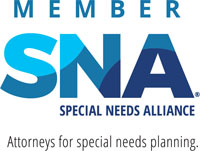Date: October 20, 2014
A brief note of introduction for this edition of The Special Needs Estate Planner is in order. This edition discusses the Supplemental Security Income (SSI) program rules for overpayments of SSI benefits. Many of our readers are trustees of Supplemental (Special) Needs Trusts (“SNTs”) and representative payees for SSI benefits, and they are well aware of how challenging – and often frustrating – it can be to interface with the administrative staff of the Social Security Administration (SSA). Written correspondence received from the agency can be confusing and even contradictory, and when contacted by phone, agency staff can often give inconsistent answers to the same question. These interactions can be difficult for attorneys and other professional advocates, not to mention SSI recipients who lack sophistication or who may have diminished capacity.
Remember that our conclusions and recommendations are based on our reading of the SSI statute, regulations and the administrative program rules, which are as complicated and dense as those found in the tax code or Medicaid program. Some readers – including SSA agency staff – may disagree with our conclusions. While we are always prepared to stand behind our position, we also recognize that in the area of SSI benefits and advocacy, reasonable minds can – and often do – differ.
With this in mind, readers are well advised to seek out professional assistance when facing the prospect of an overpayment or other penalty. This doesn’t mean that one must hire an attorney right out of the box. Many not for profit agencies serving the disability community have benefits specialists on staff, and for individuals served in a residential program and/or receiving services through a Medicaid Waiver program, service coordinators and residential program administrators may also have some practical experience in this area. As we point out below, the most important point is to act – quickly – when an overpayment issue rears its ugly head.
The Supplemental Security Income (SSI) Program
The Supplemental Security Income Program (SSI) is a means-tested government benefit program that provides financial assistance to individuals with disabilities in the form of a monthly cash payment. In order to be eligible for SSI, an individual must meet the Social Security Administration’s (SSA) definition of disability or blindness and must not have resources or income that exceed program limitations. “Resources” are items that the individual retains from month to month, like a bank account or a stock. “Countable resources” are all resources except those that SSI rules consider not countable, like clothing and other items of personal property. There is a limit of $2,000 for an individual for countable resources.
Income must also be limited in order for one to receive SSI benefits, and income isn’t defined in the traditional sense for SSI purposes. “Income” is something of value that the individual receives in a given month that can be used to provide food or shelter. It doesn’t have to be traditional wage or interest income. It can come in the form of room and board provided free of charge by a parent or someone else, payment from a trust, or an insurance settlement, among a variety of other sources. Some types of income are counted and others aren’t, making the income calculation somewhat difficult for most folks to understand. In very simple terms, the monthly SSI benefit amount is calculated by subtracting countable income from the SSI federal benefit rate, which in 2014 is $721 per month.
Many children with disabilities under the age of 18 do not receive SSI because of rules which cause the income and resources of the custodial parents to be “deemed” to belong to the child. If the custodial parents do not fall within the income and resource thresholds for SSI benefits themselves, their minor child will not be entitled to SSI.
Once the child turns 18, the SSI program no longer considers the income and resources of the parents, and only looks to the income and resources of the individual with a disability. At that point, an application for SSI will be submitted to the Social Security Administration (presuming the income and resource limitations are otherwise satisfied). As part of that application, the applicant or the applicant’s representative payee (the person or entity designated to receive the SSI benefit on behalf of the applicant) confirms that he or she will report any “change in circumstance” to the agency which would impact the SSI benefit payment.
What is an overpayment?
Since it is the responsibility of the SSI recipient or the representative payee to give notice to the agency regarding a change in the recipient’s circumstance (i.e. living situation, marriage, an increase in income or resources, etc.), an overpayment will often occur when a change in circumstance would have the effect of reducing or eliminating the SSI benefit but goes unreported for a period of time.
For example, assume Jacob is 18 years old. He has no income and no resources and meets the SSA’S definition of disability. When Jacob applies for SSI, the agency determines – based on his income, resources and living arrangement – that he is entitled to the full federal SSI benefit of $721. Two years later, Jacob’s father passes away and leaves him $10,000 which he receives directly in the month of October 2014. By mid-January of the following year the $10,000 has been spent down to less than $2,000 by purchasing a computer and other electronic equipment for Jacob. Since Jacob didn’t manage to spend-down the $10,000 in resources until the end of January, he was technically ineligible for SSI in October, November, December and January due to having resources and income in excess of the SSI program limits. As such, the payments he received during those months are “overpayments” to Jacob.
An unavoidable overpayment may also occur when an SSI recipient is working. Earnings are reported by the 10th day of the next month and the SSI benefit is adjusted in the month after that – the second month from when the earnings were received. If earnings fluctuate, it will result in an overpayment in months when earnings exceed the amount the SSA is using to calculate the SSI benefit amount.
In some cases where the Social Security Administration failed to take into account a reported fact which affected the SSI recipient’s eligibility or the amount of the cash benefit, the agency will limit the amount of the overpayment to a two-year period, even if the problem existed for a much longer period of time. This is referred to as “administrative finality.”
Keep in mind, however, that this limitation only applies in cases where a change in circumstances was reported to the agency and the agency failed to act. If the change was never reported, there is technically no retroactive limit on the overpayment.
How is an SSI recipient notified of an overpayment?
The Social Security Administration will send the SSI recipient a written notice that he or she was overpaid. The notice will state the amounts and dates of the overpayments. The notice provides either a request for a full refund (if the change of circumstance caused elimination of the SSI benefit) or will propose the withholding of a portion of future SSI benefits on a monthly basis until the overpayment is fully repaid (generally for those who have their benefit reduced – but not eliminated – by the change in circumstance).
In addition, the notice should contain a detailed, plain-language explanation of the cause of the overpayment. If you’ve ever seen one of these notices it is easy to see how reasonable minds could differ on the definition of “plain language,” but nevertheless the notice should identify the source of the overpayment and the SSI recipient’s appeal rights.
What should the SSI recipient do upon receipt of a notice of overpayment?
Generally speaking an SSI recipient has three options if he or she receives notice of an overpayment: (1) request reconsideration and possibly appeal an unfavorable decision; (2) request a waiver; or (3) request an alternative payment plan.
Reconsideration and appeal
Typically an individual should seek reconsideration if he or she believes that the amount of the overpayment or the reason supporting the assessment of the overpayment is incorrect. The reconsideration process is handled within the local Social Security Administration office, and it is an opportunity to provide the local office with additional information to establish that the overpayment or the amount of the overpayment is incorrect.
If one plans to seek reconsideration, it must be done within 60 days of receiving the notice of overpayment. If one wishes to receive his or her full SSI benefit during the reconsideration process, the request for reconsideration should be filed within 10 days of receipt of the notice of overpayment. The agency has a form, Form SSA-561, on which SSI redeterminations should be requested. This form can be found on the SSA’s website, www.ssa.gov. On the reconsideration form one must elect one of three options: a case review, an informal conference, or a formal conference. The best option usually depends upon the issues in the case.
If the SSA does not change its mind in the reconsideration process, then the SSI recipient must file a Request for Hearing on a form HA-501-U5. This form can also be found on the SSA website. The hearing will be held before an administrative law judge, and if that decision is unfavorable, the next step is to file an appeal with the Appeals Council and, if the appeal is denied, then file a petition in federal court.
Waiver
If the SSI recipient or the representative agrees that there was an overpayment, but the overpayment was not the fault of the recipient or representative, a request can be made for the waiver of all or a portion of the overpayment amount.
Consider Jacob’s initial determination of entitlement to the maximum federal benefit amount of $721. If Jacob reported that he had monthly unearned income of $200 per month in his initial application, his SSI check would have been less than the maximum amount. If his caseworker neglected to include the $200 of unearned income in the initial determination, and that income is later discovered in a review or scheduled redetermination, the overpayment was clearly not the fault of Jacob or his representative. On these facts, Jacob would be well advised to request a waiver of the overpayment.
As a general rule, in order to receive a waiver of an overpayment the recipient must show that the overpayment was not the fault of the recipient or representative payee and that forced repayment would create an undue hardship on the SSI recipient, resulting in an inability to meet everyday living expenses. In Jacob’s case, in addition to showing that he reported the income to the agency, he would need to show that the monthly reduction in his SSI benefit (taken to repay the overpayment) would prevent him from meeting his basic shelter and sustenance needs.
If an SSI recipient wishes to request waiver of an overpayment, he or she must file a Form SSA-632.
Alternate Payment Plan
If a request for waiver or reconsideration is denied, the SSI recipient can request an alternate payment arrangement with the SSA. This can take the form of a smaller amount withheld from future SSI checks on a monthly basis, often at the rate of a 10% reduction in the SSI benefit amount. In cases where the SSI benefit has been eliminated and the former recipient has limited ability to repay the full payment owed, the SSA will sometimes accept periodic payments or compromise the amount owed.
Who can repay the overpayment?
It is not uncommon to encounter a circumstance where an SSI beneficiary has a small withholding each month and a parent or other concerned individual wishes to satisfy the overpayment on behalf of the recipient so that the full benefit amount can be restored. There is nothing in the SSI program rules which prevent a third party (like a friend or relative) from satisfying the overpayment.
In other circumstances, trustees of Supplemental Needs Trusts wish to repay an overpayment from the funds held in the SSI recipient’s trust. In our opinion, this is an allowable trust distribution. That said, the authors understand that some Social Security Administration offices have taken the position that SSI repayments are not permissible distributions from an SNT. We believe this to be an absurd position and unsupported by any credible reading of the SSI law and rules.
Can overpayments be avoided?
In many cases, the answer is ‘yes.’ Think about Jacob’s case. He received a direct inheritance from his father. Had Jacob’s father sought proper advice from a competent special needs planning attorney, he would have left Jacob’s inheritance to a supplemental needs trust for Jacob’s benefit. If the trust was drafted correctly, the funds in the trust would not be considered a ‘countable resource’ for SSI purposes, and Jacob’s SSI benefits would have remained intact.
That said, sometimes an overpayment is unavoidable. In our opinion, as soon as a change in circumstance giving rise to an overpayment is discovered, the best course of action is for the SSI recipient and/or the recipient’s representative to consult with a special needs planning attorney or other qualified professional to develop a plan for addressing the overpayment and reporting the overpayment to the SSA. Sometimes a special needs trust needs to be created in order to re-establish financial eligibility. Sometimes there are other ways to protect a financial windfall and minimize the size of the overpayment. The worst thing an SSI recipient can do is to ignore the issue and leave it unreported.
*This article originally appeared in substantially the same form in The Voice, a publication of the Special Needs Alliance, a national organization of attorneys who work in the area of disability and special needs law. Tara Anne Pleat and Edward V. Wilcenski are members of the Alliance and write frequently for its publications.
Firm Notes and News
Edward V. Wilcenski has been named to the New York Super Lawyers list as one of the top Elder Law Attorneys in New York State for 2014. Super Lawyers selects no more than 5% of the lawyers in New York State for this designation. This is the fourth year Ed has received this honor.
Tara Anne Pleat and Michael D. Dezik have been named to the New York Super Lawyers Rising Star list as two of the top Elder Law attorneys in New York State under the age of 40 for the year 2014. Super Lawyers selects no more than 2.5% of the lawyers in New York State for this designation. This is the second year that Tara has received this honor.
Tara Anne Pleat presented at the Summer Meeting of the Elder Law and Special Needs Section of the New York State Bar Association, speaking on Home and Community Based Medicaid programs for the elderly and individuals with disabilities.
Michael D. Dezik has been selected as a “20 Under 40” Honoree for 2014 from the Glens Falls based newspaper, the Post Star. Each year the Post Star seeks nominations from the greater Glens Falls/Southern Adirondack community to honor people under the age of 40 who have demonstrated success and dedication to their careers, and who are considered role models in their communities.
Paralegal Maureen Provost took and successfully passed the Paralegal Advanced Competency Exam (PACE) offered by the National Federation of Paralegal Associations, Inc., granting her the Registered Paralegal (R.P.) credential. PACE is a voluntary, proficiency-based exam, designed to test the competency level of experienced paralegals. Congratulations Mau!
Wilcenski & Pleat PLLC
Wilcenski & Pleat PLLC is a law firm focused entirely on Special Needs Estate Planning, Elder Law, and Trust & Estate Planning. Our Special Needs Estate Planning practice involves Special (Supplemental) Needs Trusts for individuals with disabilities, guardianship proceedings, Medicaid applications and other government benefit advocacy. We work with special education professionals serving students of all ages, personal injury attorneys settling cases on behalf of permanently disabled plaintiffs, service coordinators providing support to consumers, and financial professionals and corporate trustees managing funds for the disabled.
This newsletter is not intended as a substitute for legal counsel. While every precaution has been taken to make this newsletter accurate, we assume no responsibility for errors or omissions, or for damages resulting from the use of the information in this newsletter. If you would like to be removed from our distribution list, please email us or call us at (518) 881-1621















